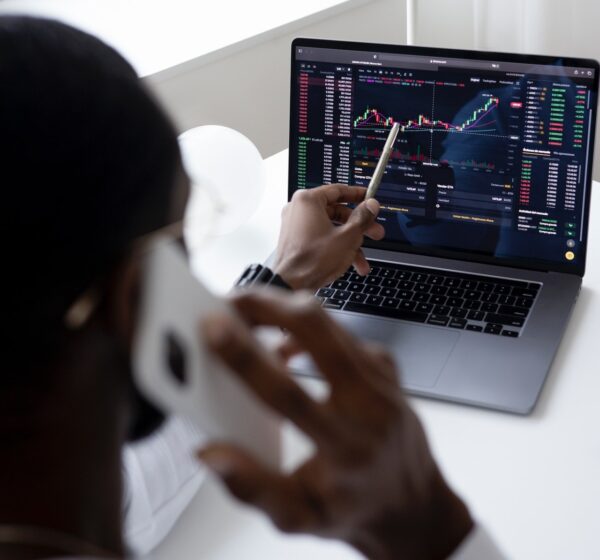By Rita Nazareth
Stock traders took risk off the table at the end of a week that saw recession fears resurface and a hotter-than-estimated inflation print with the Federal Reserve decision just around the corner.

A late-day slide in equities shattered the calm that prevailed throughout most of the trading session, with the S&P 500 closing near Friday’s lows. The Dow Jones Industrial Average notched its worst weekly drop since September. Treasury 10-year yields climbed, approaching 3.6%.
In the run-up to the Fed meeting, all eyes will be on Tuesday’s consumer inflation data — which is forecast to show prices, while much too high, continued to decelerate. Swaps signaled bets policymakers will raise rates by 50 basis points Wednesday after four straight 75 basis-point hikes. Officials including Chair Jerome Powell have been indicating a downshift, while stressing borrowing costs will need to remain restrictive for some time to beat inflation.
“Bottom line: the Fed has already come to terms with the fact that they are likely risking a recession, to anchor inflation longer-term,” said Don Rissmiller at Strategas. “The job is not done. Rate hikes can likely slow down to 50 bp, but we are still looking at policy tightening (and staying tight) in 2023.”
Financial conditions have eased dramatically since the October consumer-price reading, so the Fed will likely use the December meeting to walk those back, according to Cliff Hodge at Cornerstone Wealth. The most straightforward way to do so would be the Summary of Economic Projections — specifically the so-called dot plot, he noted.
“We think the markets are too sanguine on rates after the first quarter, and we expect Powell to take a more hawkish tone and for the dots to indicate higher rates for a longer period of time than what is currently being priced in by the futures markets,” Hodge said. “A ‘hawkish’ step-down so to say.”
The Fed is set to keep rates at their peak throughout 2023, dashing hopes markets have priced in for rate cuts in the second half, according to economists surveyed by Bloomberg.
The Federal Open Market Committee’s median projection is expected to show the benchmark peaking at 4.9% in 2023 — reflecting a 4.75%-5% target range — compared to 4.6% seen in September. That would deliver a hawkish surprise to investors — who currently bet rates will be cut by a half percentage point in the second half of next year, though they too see rates peaking around 4.9%. The current range is between 3.75% and 4%.
While many investors are impatient for the Fed to deliver its last rate hike, history shows they should be wary of doing so while inflation remains elevated, according to Bank of America Corp. strategists.
An analysis by Michael Hartnett showed that stocks outperformed after the Fed stopped increasing rates during periods of disinflation in the past 30 years. However, during the era of high inflation in the 1970s and 1980s, equities had fallen after the last hike, they wrote. In the current cycle, they expect the Fed to raise rates for the last time in March 2023.
After analyzing 15 economic downturns going back to 1929, strategists at Bloomberg Intelligence found a strong link between the length of recessions and the time it took the S&P 500 to reclaim its previous high.
In all instances, it’s taken the gauge about 386 days to reach the bottom and 573 days to recover to peak levels. But if the bottoming process took longer than average, the road to reclaim a previous peak has then lasted 1,997 days, six times the length of the ascents that came after a quicker-than-average bottoming process.
Stocks might be on track for their worst returns since the global financial crisis, but the market has endured the most daily routs in almost five decades, according to data compiled by Bloomberg as of Wednesday’s close. Those selloffs are calculated by a so-called hit ratio that measures the number of gains versus losses as a percentage of the total number of trading days.
That ratio stands at 43%, the S&P 500’s lowest since 1974. An annual hit ratio lower than 50% has only been seen 10 other times in the past 48 years, and the recovery has been painfully slow in most cases
Still, some of the world’s biggest investors predict that stocks will see low double-digit gains next year. Seventy one percent of respondents in a Bloomberg News survey expect equities to rise, versus 19% forecasting declines. For those seeing gains, the average response was a 10% return.
Some of the main moves in markets:
Stocks
- The S&P 500 fell 0.7% as of 4 p.m. New York time
- The Nasdaq 100 fell 0.6%
- The Dow Jones Industrial Average fell 0.9%
- The MSCI World index fell 0.2%
Currencies
- The Bloomberg Dollar Spot Index rose 0.1%
- The euro fell 0.2% to $1.0530
- The British pound rose 0.2% to $1.2255
- The Japanese yen was little changed at 136.71 per dollar
Cryptocurrencies
- Bitcoin fell 0.5% to $17,099.03
- Ether fell 1.3% to $1,261.63
Bonds
- The yield on 10-year Treasuries advanced 10 basis points to 3.58%
- Germany’s 10-year yield advanced 11 basis points to 1.93%
- Britain’s 10-year yield advanced nine basis points to 3.18%
Commodities
- West Texas Intermediate crude was little changed
- Gold futures rose 0.3% to $1,807.30 an ounce
This story was produced with the assistance of Bloomberg Automation.
–With assistance from Elena Popina.
More stories like this are available on bloomberg.com.




